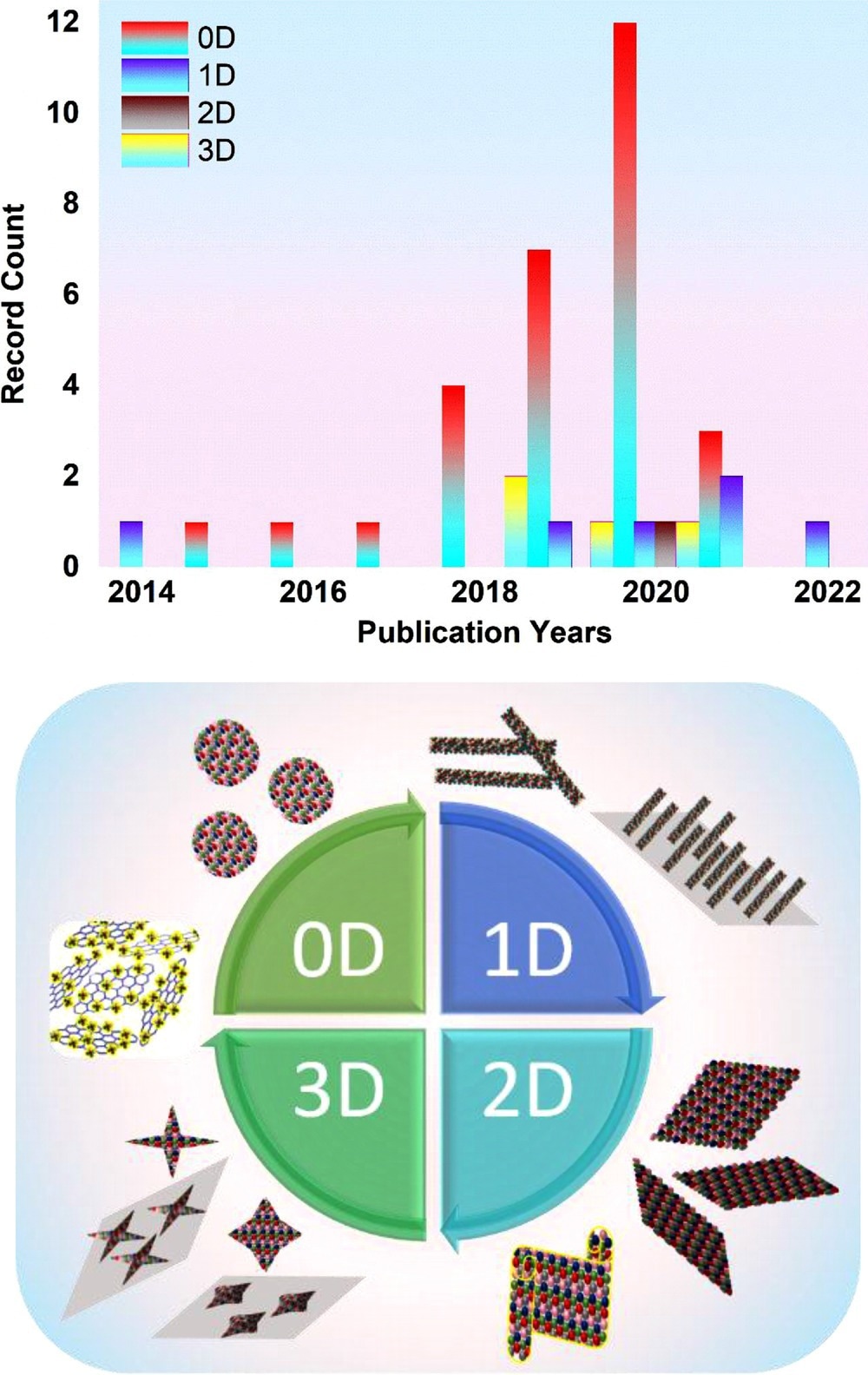High-entropy alloys offer the scope for extensive compositional space by mixing multiple elements to develop novel materials. Mixing multiple elements to form alloys at the nanoscale offers outstanding functionalities and tunes the native chemical and physical properties of high-entropy alloys.

Histogram illustrating the articles published to date on 0D, 1D, 2D, and 3D HEA nanoarchitectures and the scope of the current review. © Pavithra, C. L. P & Dey, S. R (2022)
Although developing multi-dimensional alloys with complex nanostructures via mixing multiple elements with boundless compositions and combinations is rewarding, realizing such materials is challenging.
In this regard, various methods have been proposed for developing multi-element alloys with zero-dimensional (0D) to three-dimensional (3D) nanostructures. However, multi-element alloys with element combinations are limited to noble metals and 0D nanoparticles. An article published in Nano Select discussed the key developments in high-entropy alloy nanoarchitectures and summarized related strategies.
What are High-Entropy Alloy Nanostructures?
High-entropy alloy nanostructures are nanosized alloy structures with different dimensions (0D to 3D) containing more than four elements blended as a single solid solution with a distinct shape. Although bulk high-entropy alloys are prepared via conventional approaches, their nanosized counterparts cannot be prepared using the same strategies due to their complexity of alloying different elements into a single solid-solution nanostructure.
Moreover, it is essential to investigate the prospects of such materials due to their high entropy (emerging from mixing multiple elements), surface chemistry, dimensional anisotropy, and chemical composition space, for various applications, including catalysis, energy, environmental, plasmonics, and biomedical applications.
Recently achieved high-entropy alloy nanostructures via novel synthetic strategies include 0D nanoparticles, 1D nanotubes and nanowires, 2D nanoscrolls and nanosheets, and 3D lattice and nanohybrids.
Synthesis of Nanostructured High-Entropy Alloys
Various unconventional approaches have been proposed to synthesize high-entropy alloy nanoparticles. Among the existing methods, carbothermal shock synthesis has played a prominent role in synthesizing multi-element alloy nanostructures. This process overcomes the immiscibility of elements by forming a uniform liquid mixture at elevated temperatures, which further forms alloys upon rapid quenching.
The aerosol synthesis method is used to synthesize multi-element or high-entropy alloy nanoparticles, where the atomic-level mixing of multiple immiscible elements is not possible via traditional techniques.
Although the methodology involved in aerosol synthesis is complementary to carbothermal shock synthesis, the former overcomes the drawbacks encountered by the latter. Hence, similar to carbothermal shock synthesis, aerosol synthesis involves the formation of aqueous solutions of metal salts comprising the required alloying elements.
Chemical methods, on the other hand, involve a variety of reactions in the liquid phase with precursors under appropriate experimental conditions to yield essential materials with desired morphologies, sizes, phases, and compositions.
Typically, these methods are used to synthesize 2D materials and nanoparticles when conventional top-down methods are not feasible. Furthermore, chemical methods provide excellent reproducibility in the fabrication of nanomaterials. However, only a few efforts have been made to obtain multicomponent alloy nanoparticles using this method.
Scope for High-Entropy Alloy Nanostructures
Progress in high-entropy alloys at the nanoscale level has been mostly limited to noble-metal-based alloy systems, whose applications are primarily focused on catalytic reactions. Furthermore, synthetic routes for preparing concentrated complex alloys, such as high-entropy alloys, are limited and generally restricted to 0D, with few attempts toward one-dimensional (1D) and two-dimensional (2D).
Despite a few previous reports on 3D lattices and composites, including graphene, 2D material-decorated nano-high-entropy alloys, and high-entropy alloy-coated polymer nanolattices, there is still a wide scope for advancement in high-entropy alloys, including 1D, 2D, and 3D nanostructures.
Various physical and chemical synthetic routes have demonstrated the possibility of producing 0D high-entropy alloy nanoparticles using colloidal suspensions and supports. Each method has its advantages and disadvantages. However, few methods are complementary in terms of scalability and creation of high-entropy alloy nanoparticles with boundless compositions and combinations, regardless of their compatibilities and immiscibility.
Furthermore, element combinations (apart from noble metals) and topology can be investigated for various unexplored applications. Similarly, while significant progress has not been made in 1D and 3D materials, there are still numerous opportunities for exploring limitless combinations of high-entropy alloys in the nanometer range. Some 0D material preparation methods can also be utilized to synthesize 1D and 3D materials.
Conclusion
Overall, advances in high-entropy alloys will encourage investigators to expand their work beyond 0D high-entropy alloy nanoparticles to various distinct morphologies with indefinite element combinations, potentially opening new pathways for promising applications and unknown technologies.
This review has provided future directions and scope for the design and development of new families of high-entropy alloy nanoarchitectures with wide compositional space in unique shapes for a variety of unexplored applications.
Reference
Pavithra, C. L. P & Dey, S. R (2022) Advances on multi-dimensional high-entropy alloy nanoarchitectures: Unconventional strategies and prospects. Nano Select. https://doi.org/10.1002/nano.202200081
Disclaimer: The views expressed here are those of the author expressed in their private capacity and do not necessarily represent the views of AZoM.com Limited T/A AZoNetwork the owner and operator of this website. This disclaimer forms part of the Terms and conditions of use of this website.